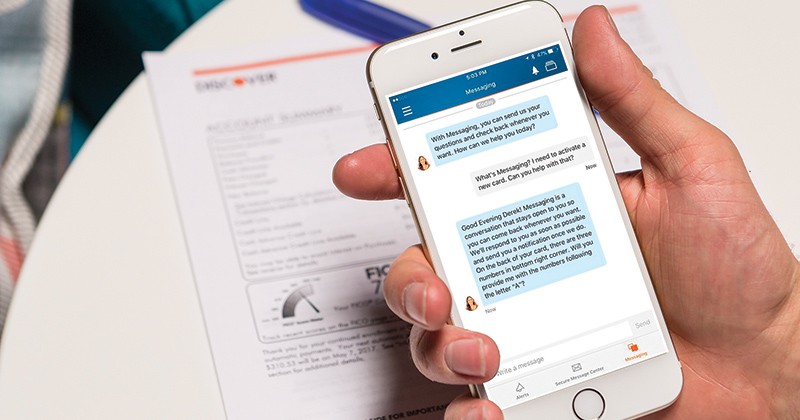Most consumers prefer to use their phones to communicate with friends, family, and businesses—but it’s not to make a phone call. More than half (66 percent) of consumers prefer to communicate via mobile messaging over any other means, according to research by cloud communications platform Twilio. And eMarketer estimates more than one-quarter of the world’s population will be using mobile messaging apps by 2019.
Why is mobile messaging so popular? Messaging provides convenience, personalization, and efficiency. It makes customer service faster and more efficient by enabling direct communication between customers and service representatives. And while brands struggled to reach consumers through native SMS, which sends a message to a phone number, in-app messaging allows brands to communicate with consumers in a less intrusive manner.
In-app messaging simplifies the customer experience and can even influence the type of inquiries customers make, says Dennis Michel, senior vice president of customer service and engagement at Discover Financial Services. Earlier this year, the credit card company added messaging to its Discover mobile app. The company gained much insight from its experience introducing mobile messaging as a customer service option.
Keeping up with communication trends
The company decided to offer in-app messaging as a customer service channel after research showed it was a rapidly developing trend. “It’s not as if customers told us they were unhappy with the other options [phone, email, chat, and social media], but the fact is consumers interact over text,” Michel says. “So this was about understanding how people like to communicate today and giving them that option.”
In May, Discover rolled out the messaging service to a quarter of its approximately 6 million app users to study the technology before introducing it to its entire user base a few months later.
In-app messaging improves several aspects of the company’s Live Chat feature, which will be replaced by the messaging feature. For example, when the chat session starts, customers must stay connected until their problem is resolved. If the chat is interrupted, the customer must start a new session and repeat his or her question with a different associate.
In contrast, messaging allows customers to exchange messages with a representative at their convenience without having to repeat the question each time. Even if the message thread is passed to a new representative, all representatives have access to the messaging history, making it easy for them to pick up where the conversation left off.
And starting this fall, customers will be able to initiate a message thread from other channels, like a desktop computer, and continue the conversation from the app. The company also applies predictive analytics to CRM data that it collects about customers, including their clickstream activity on Discover’s site, to predict the nature of the inquiry. Insights from the data are shared with representatives to help them serve customers more efficiently.
So what types of questions do Discover customers ask over in-app messaging? A few differences quickly stood out compared to more traditional channels, according to Michel. For instance, customers were more likely to ask which restaurants would be included in next month’s 5% Cashback Bonus program over messaging versus the phone. “Our theory is that customers might not want to invest the time in asking certain questions, but messaging is so easy that they have no problem asking questions they wouldn’t have before,” he says.
As for response times, Discover tries to respond to messages nearly as quickly as it responds to phone calls. Associates are expected to answer 90 percent of calls within 60 seconds. At the time this article was written, the average response time to an in-app message was two minutes. The company is evaluating its approach to messaging to determine the best way to speed up its response time, such as by adding more representatives or prioritizing inquiry types.
Paging the bots
Today, only humans respond to messages sent through Discover’s messaging feature, but that could eventually change. The company already uses bots to assist humans by categorizing inquiry types. When customers ask certain questions, such as about procedures and policies, a bot will “push” it to a human associate to expedite the response. Discover is considering expanding the bots’ roles, which could include interacting with customers for certain requests. “We are looking into introducing more bots to expedite the customer experience, but not to replace humans entirely,” Michel says.
The popularity of the messaging feature suggests Discover will need all the help it can get to support customers. At the end of each exchange, customers are asked to rate the quality of their experience on a 5-star scale. Within a few weeks after launching the messaging feature, its average star rating was 4.8 and “a little over 95 percent of respondents gave us fours or fives, so it’s been very positive,” Michel says.
Many customers still contact Discover via phone—the company receives 6 to 7 million calls each month—but messaging is quickly catching up. Within a few weeks after the new feature was launched, representatives received 12,000 messages. And that was when the feature was only available to 25 percent of app users.
“We expect to see even more users as we make [the messaging feature] more readily available,” Michel says. “But our roadmap suggests that while we have a lot of people using our app and in-app messaging, customers are spending the majority of their time on other services like Facebook, so we want to make sure we’re there as well.” The company plans to make its in-app messaging service available through Facebook Messenger and is also considering other platforms like Twitter.
These plans reflect the company’s ultimate strategy: to make the customer experience as easy as possible. “We’re a big believer in the idea that customers have other things they’d rather do than call their credit card company,” Michel says. “But when they do contact us, a primary objective in the service environment at Discover has been to create low-effort experiences. Messaging is just one more example of that.”















